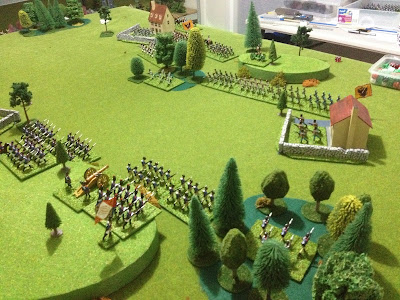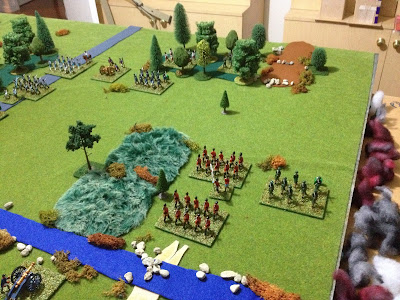Over the weekend I played a grid-based science fiction skirmish game. In the scenario a cargo flyer has crashed and its cargo has been strewn randomly around the table in four locations. Two gangs, Scavengers and Mercs, arrive quickly on opposite sides of the table in search of easy pickings. However, two crewmen of the downed flyer have survived and are hunkered down in the crash site. They will shoot at any units moving to a square containing cargo or coming within any adjacent squares.
 |
| Setup of the game with the cargo flyer crash site in the centre |
 |
| A couple of Scavengers advance towards some cargo and come under accurate fire from the Flyer's crew. |
 |
| From another position other Scavengers provide some crossfire |
 |
| The Mercs can be seen in the background advancing towards some of the cargo. |
 |
| Other Merc gang members move up under cover behind the buildings |
The rules I am using are house rules. I have written them up as a first draft. Mainly so I can remember what I eventually decided upon. My rules notes have notes on top of notes, and when I return to them in a week or so, I will have forget which rules I rejected.
Some areas of the rules I have settled upon I have included as snippets in this battle report.
Sequence of play
The game is played in a series of turns.
Both players roll a D6 and the scores are used to determine which player activates a figures and the number of actions a figure can perform.
- If D6 scores are drawn, then the player who is in control gets to activate one of their figures with 1 action point.
- A player with a higher D6 score the get to activate one of their figures with 2 action points.
- If a player has a higher D6 score which is three time the other player’s D6 score, they activate one of their figures with 3 action points.
A turn ends when both players have had an opportunity to activate all their figures.
 |
| Both gangs are firing at the crewmen |
 |
| The Scavengers bring up their flamer |
 |
| The crewman are eliminated... |
 |
| ...and the gangs turn their attention on each other. |
Actions
When a player activates a figure they get to perform a number of actions. Each action has an action point (AP) cost. A figure may not exceed their action points and cannot carry forward action points not used.
- Move (1 AP) - a figure can move 1 zone. A figure can move multiple times as part of their activation.
- Shoot (1 AP) - a figure can shoot their weapon. A figure can only shoot once in their activation.
- Reload (1 AP) - a figure can reload their weapon if out of ammunition.
- Aimed Shooting (2 AP) - a figure can take an aimed shot with their weapon. A figure can only shoot once in their activation.
- Pickup/Drop an item (1 AP)
- Throw a grenade (2 AP)
- Patch up a wound/damage (2 AP)
- Pinned/Recover from being pinned (1 AP)
- Close Combat (1 AP) - a figure already in the same zone as an enemy figure can move into base contact. Multiple close combat actions increase the D6 rolled.
Figures with a wound reduce their actions by 1 AP. (So a wounded figure requires 3 APs to recover.)
 |
| Support fire from the Merc members in the vegetation kills one of the scavengers |
 |
| The Mercs try and move in on some more of the cargo |
 |
| Combat between the gangs is scattered as various members take their stolen cargo items back to their starting positions. |
 |
| Fighting occurs over the downed flyer's wreckage |
 |
| The Scavengers get the better of their opponent Mers |
 |
| The Mercs break off the attack after losing more than 50 percent of their number |
Shooting
Weapons have three ranges: short, long and extreme.
When shooting a player selects a single target figure in a zone which can be seen by the shooting figure.
- When shooting roll 2D6 at short range and 1D6 at long range.
- Aimed fire allows an addition D6 to be rolled. So a figure rolls 3D6 at short range, 2D6 at long range, and 1D6 at extreme range.
Shooting Results - After a shooter has rolled all their D6. Select the D6 with the highest score.
The target figure now has to roll 1 or more D6 to beat the shooter’s score.
All target figures roll a minimum of 1D6. They can add:
- 1D6 for wearing armour
- 1D6 for occupying a zone with cover.
- 1D6 for if they have "hit the dirt".
The target figure rolls all their D6. Then compare their highest scoring D6 to the shooter’s highest score.
- If the scores are equal the target figure is pinned.
- If the target score is less, then the figure is wounded.
- If the target score is less by a factor of 3, then the figure is killed.
Targets which receive 2 wounds are treated as killed.
I hope to play a few more games as I get one or two more Necromunda figures painted up to add to the gang numbers.































































